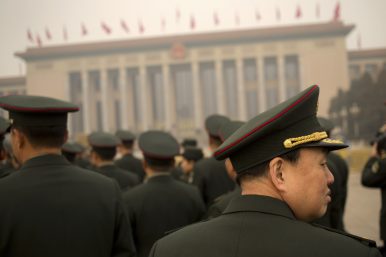By Rajeswari Pillai Rajagopalan
 China recently announced a defense budget of 1.19 trillion yen ($177.61 billion). This represents a slower growth rate in the budget, falling to 7.5 percent as against an 8.1 percent increase in 2018. Nevertheless, there are likely to be predictable expressions of concerns at the size of even the publicly announced budget, considering that it is more than three times as large as India’s, which has the second largest defense budget in Asia.
China recently announced a defense budget of 1.19 trillion yen ($177.61 billion). This represents a slower growth rate in the budget, falling to 7.5 percent as against an 8.1 percent increase in 2018. Nevertheless, there are likely to be predictable expressions of concerns at the size of even the publicly announced budget, considering that it is more than three times as large as India’s, which has the second largest defense budget in Asia.China’s military power has expanded dramatically in the last several years. A recent report by the International Institute of Strategic Studies (IISS) noted that “since 2014, China has launched more submarines, warships, principal amphibious vessels and auxiliaries than the total number of ships currently serving in the navies of Germany, India, Spain, Taiwan, and the United Kingdom.”
Beijing has been closing the gap even with the United States, though the latter still maintains a considerable lead. Where China has been not able to catch up, it has developed certain asymmetric capabilities to compete with the United States. As Andrew Erickson points out, “In many areas, they have weapons systems that only a few other countries possess.” The development of the People’s Liberation Army’s capabilities across all domains has been “impressive” under Xi’s leadership.
Such growth has also led to concerns in the neighborhood. Even countries like South Korea that have generally had good relations with China are beginning to face hostile actions from the Chinese PLA. For more than a year now, there have been repeated violations of the South Korean air defense identification zone (Korea-ADIZ) by the PLA Air Force, the most recent one in late-February.
However, these foreign concerns are falling on deaf ears in China. Headlines like “history proves China’s defense budget growth benefits the world” appear to be more the norm. Officially, Zhang Yesui, spokesperson for the annual session of the 13th National People’s Congress, termed the defense budget hike as “reasonable and appropriate.”
China has continued to reiterate that much of the hike in the defense expenditure goes to meet the salaries and other benefits of the troops, in addition to developing weapon systems, military reforms, and training. It has tried to make the case that China still lags behind a number of countries like the United States and that there are outdated systems and platforms that need to be replaced.
A quick look suggests that China’s defense analysts are largely reiterating the official line. Commenting on the defense budget announcement, Xu Guangyu, a senior consultant with the China Arms Control and Disarmament Association, noted that the Chinese military has reached “a normal and stable speed instead of a premature rush.” Chinese analysts also slammed reports that say the Chinese spending in actuality is much bigger than what is announced by the Chinese authorities, saying that “China’s military modernization is meant for self-defense and not threatening other countries. We should not care much about what others say.”
Many Chinese military analysts have also tried to highlight the fact that its defense spending has moved away from a double-digit growth rate since 2016. Chinese military analyst Li Daguang from the National Defense University of the PLA argued that the defense spending of 2018, which was 1.107 trillion yuan, was only 1.3 percent of China’s GDP, a much smaller proportion compared to other countries like the United States and Russia that spend around 4 percent of the GDP on defense. Instead, there are suggestions that as China engages in more international projects such as the Belt and Road Initiative, its security concerns will only go up and accordingly, “it must speed up its national defense power to protect the legitimate interests of Chinese people.”
Broader ambitions are also driving China’s defense budgets. Xi Jinping has outlined important goals for China in the next few decades as part of his Chinese Dream. The Chinese Communist Party (CCP) is all set to celebrate its 100th anniversary in 2021, by which time China hopes to have a “moderately well-off society.” The second major centenary goal is the 100th anniversary of the founding of the People’s Republic of China itself and China hopes to be “a completely developed country” by 2049.
Along with these broad goals, China has specified areas for focus like military drones, space, artificial intelligence, and overall development in the strategic domain. The Chinese Dream of national rejuvenation could see a lot more emphasis in the coming years with higher spending on each of these high-tech and defense arena. But China – and Chinese analysts – should take greater cognizance of the concerns around the region.
